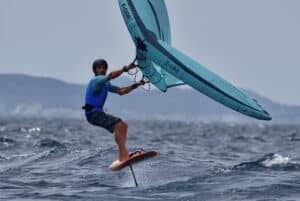Kitesurfing is so addictive due to its unique blend of adrenaline-pumping action, physical challenge, and mental liberation. This exhilarating water sport combines elements from various activities, offering a versatile experience that appeals to thrill-seekers and nature enthusiasts alike.

Mixture of Many Sports Together
Kitesurfing’s addictive nature can be attributed to its unique blend of various popular water sports and outdoor activities. This combination creates a thrilling experience that appeals to a wide range of kite surf students and enthusiasts. The sport incorporates elements from Surfing, Windsurfing, Wakeboarding, Paragliding and Gymnastics.
The combination of these elements creates a unique “kite feeling” that many enthusiasts describe as unparalleled. According to a survey conducted by Kitesurfing Lanka, 87% of kite addicts reported that the sport’s multifaceted nature was a significant factor in their continued participation (Kitesurfing Lanka, 2021).
Versatility
One of the most significant aspects of kitesurfing’s versatility is its ability to accommodate different wind conditions. While many kite surf students and kite schools prefer consistent, moderate winds, experienced riders can enjoy both light wind days and heavy wind situations.
The versatility of kitesurfing extends to the environments in which it can be practiced. While many associate the sport with tropical beaches like Kite Beach in the Dominican Republic, kitesurfing can be enjoyed in a variety of settings. From cold water locations in winter time to deep water ocean conditions, the sport adapts to different geographical contexts. This adaptability has led to the emergence of kitesurfing spots worldwide, with the Global Kitesports Association reporting over 1,500 recognized kite spots across 65 countries.

High Sensation Seeking Behavior
Kitesurfing addiction is a real phenomenon, driven by the sport’s ability to trigger the release of “feel-good” neurotransmitters in the brain. This high sensation seeking behavior is a key factor in why kitesurfing becomes so addictive for many enthusiasts.
When engaging in kitesurfing, the brain releases a cocktail of neurotransmitters that contribute to feelings of euphoria, excitement, and well-being. These include Dopamine, Serotonin, Endorphins and Adrenaline.
New Friendships
Kite surf students often find themselves bonding quickly with fellow learners and kite surf teachers at kite schools. The shared experience of learning a challenging new skill creates a strong sense of camaraderie. According to a survey conducted by Kitesurfing Lanka, 87% of kite surf students reported making new friends during their lessons, with 62% maintaining these friendships long after their initial training.
Even during light wind days or winter time when conditions are less favorable, the kitesurfing community remains active. Kite stations often become social hubs where enthusiasts gather to discuss gear, plan future trips, or participate in cross-training activities like bike rides. This continuous interaction helps maintain the sense of community and keeps the kitesurfing addiction alive even when not on the water.

The Sense of Freedom
Kitesurfing offers an unparalleled sense of freedom that contributes significantly to its addictive nature.
Unlike other popular water sports, kitesurfing provides a three-dimensional playground, allowing riders to not only skim across the water but also soar through the air. This combination of horizontal and vertical movement creates a sensation of boundless freedom that is hard to replicate in other activities.
Disconnection from Life You Get
When you’re out on the water, whether it’s at a popular kite surf spot or one of the many Favorite Beaches around the world, you’re fully immersed in the present moment. The combination of wind, water, and the challenge of controlling your kite demands your complete attention, leaving little room for thoughts about work, responsibilities, or everyday stresses.
Kitesurfing Lanka, a renowned destination for kite addicts, offers an excellent example of this disconnection. Kite surf students often report feeling a sense of freedom and detachment from their regular lives while enjoying the awesome kitesurfing conditions.

Provides an Intense Full-Body Workout
The core muscles are particularly targeted during kitesurfing sessions. As kite surf students maintain balance and control their boards, they continuously engage their abdominal and lower back muscles. This constant activation helps strengthen the core, improving overall stability and posture.
Upper body strength is also significantly enhanced through kitesurfing. Controlling the kite requires substantial arm, shoulder, and chest engagement. A study published in the Journal of Sports Science and Medicine found that kitesurfers experienced a 20% increase in upper body strength after just eight weeks of regular practice.
Cardiovascular fitness is another significant benefit of kitesurfing. A typical kite session can burn between 500-1000 calories per hour. This high-energy expenditure contributes to improved heart health and increased stamina.
Improve Mental Health
Kitesurfing has a significant positive effect on mental health, making it an attractive activity for kite surf students and enthusiasts alike. The sport combines physical exertion with exposure to nature, both of which are known to contribute to improved mental well-being.
Research has shown that engaging in outdoor activities like kitesurfing can reduce stress, anxiety, and depression. A study published in the Journal of Environmental Psychology found that spending time in natural environments, such as kite spots and beaches, can lower cortisol levels and improve mood .
Conclusion
Kitesurfing’s addictive nature stems from its unique blend of exhilaration, versatility, and holistic benefits. This thrilling water sport combines elements from various activities, offering endless possibilities for adventure and skill development.
The high-sensation seeking behavior it encourages triggers a potent cocktail of feel-good neurotransmitters, creating an irresistible rush that keeps enthusiasts coming back for more. Beyond the physical thrill, kitesurfing fosters new friendships, provides a sense of freedom, and offers a much-needed escape from daily life’s stresses. The intense full-body workout it delivers not only sculpts the physique but also significantly improves mental health, making it a powerful tool for overall well-being.
